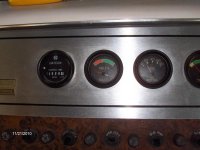Hi guys, I have a 1980 searay sedan with a 454, with two batteries and a red Perko of the 1-2-all-off variety.
I have noticed that the voltage gauge on the dash always runs low on both the flybridge and the inside helm. They both seem to set themselves with the needle in the discharge area. But, the PO said that it has always been that way (for six years) and the batteries have always been fine. Starts great. He thought it was "just hooked up wrong but never changed it".
The gauge also doesn't work the way you expect, with it raising up with revving or whatever. Just kind of stays wobbling around the discharge area. Any ideas? Thanks, Pal
I have noticed that the voltage gauge on the dash always runs low on both the flybridge and the inside helm. They both seem to set themselves with the needle in the discharge area. But, the PO said that it has always been that way (for six years) and the batteries have always been fine. Starts great. He thought it was "just hooked up wrong but never changed it".
The gauge also doesn't work the way you expect, with it raising up with revving or whatever. Just kind of stays wobbling around the discharge area. Any ideas? Thanks, Pal



